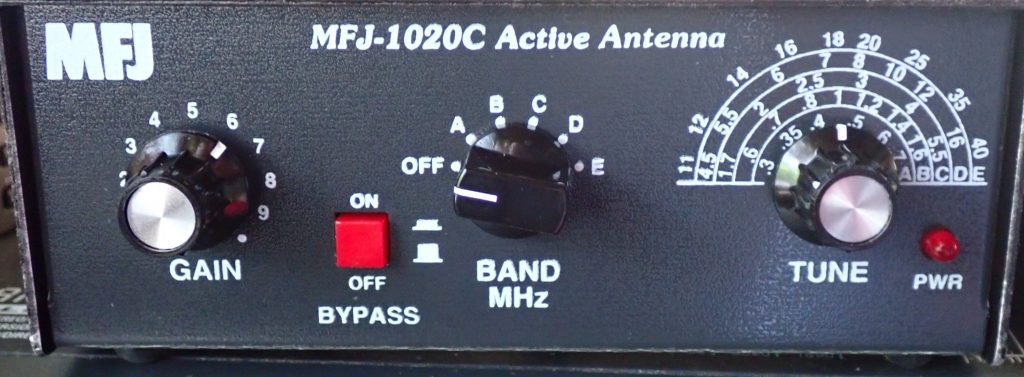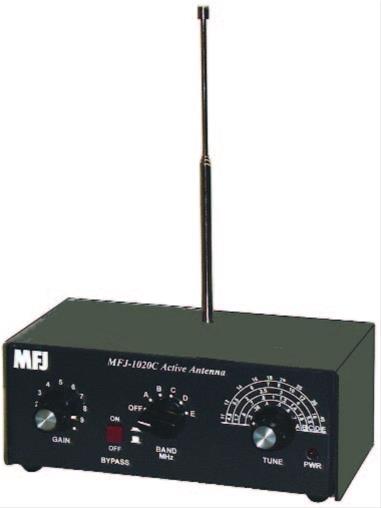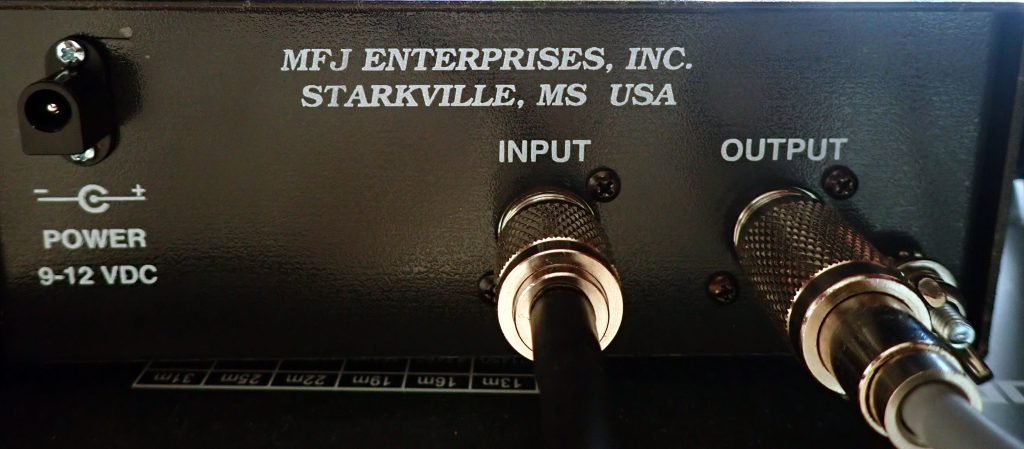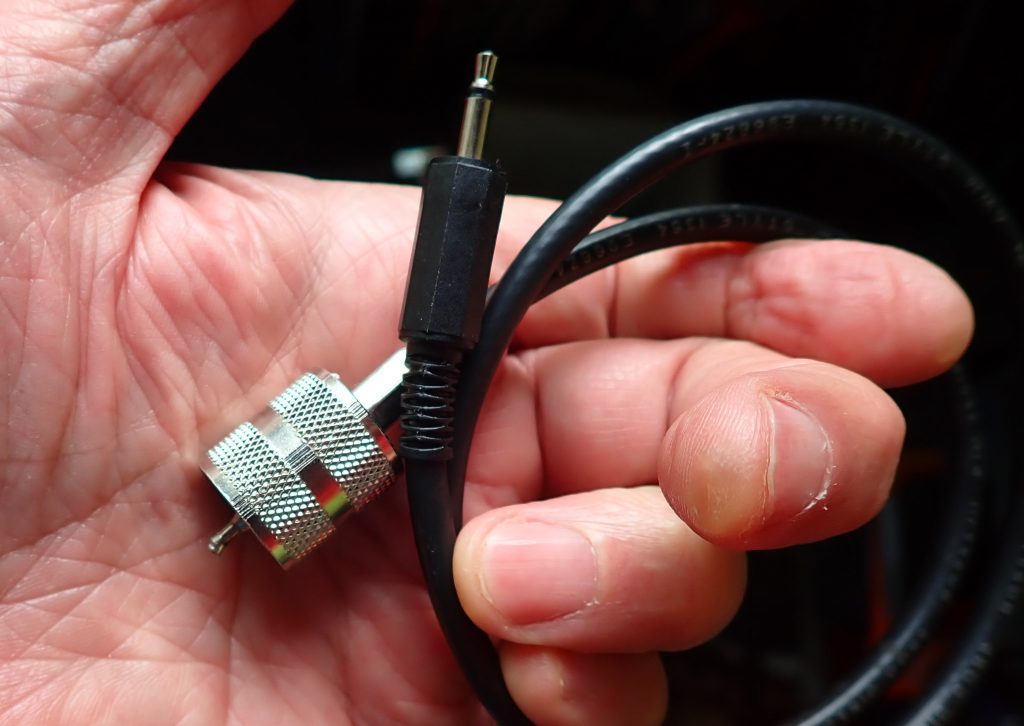Truth be told, I’ve been curious about the MFJ 1020C for a long time. Back when I wrote for Passport to World Band Radio, over a decade ago, I wondered if the 1020C was a worthwhile device, but then I had a big wire antenna outside connected to a communications receiver, so I didn’t worry so much about squeezing every last erg out of the signals I was receiving. As a result, I never experimented with an MFJ 1020C.
Now, however, I have a 50-foot indoor end-fed wire antenna connected to a Grundig Satellit 800, and I am constantly looking to improve the signal. Feeding the signal through a 9:1 unun and then through coax to the Satellit 800 has boosted the signal-to-noise ratio a bit — https://swling.com/blog/2022/05/the-satellit-800-the-tecsun-pl-880-and-two-indoor-antennas-an-afternoon-of-experimentation/ — and so has grounding the unun — https://swling.com/blog/2022/05/jock-gets-a-good-grounding/. But is there such a thing as too much signal to noise? Not in my not-so-humble opinion, so the quest for improvement continues.
During a phone call with Thomas (Maximum Leader of SWLing.com), I mentioned my curiosity about the 1020C. Thomas said, “MFJ is a sponsor of SWLing.com, I’ll see if they would like to send you one for testing.” Two days later, a package arrived with the 1020C, a power supply for it, and a short coax jumper.
 The Basic Layout
The Basic Layout
The 1020C is small — 2.5” H x 6.4” W x 3.3” D – and looks well made. It covers 300 KHz to 40 MHz. On the front panel are two knobs, a push button, and a selector switch. The left-most knob controls the gain of the amplifier. Moving to the right, you’ll find a push button that controls the bypass circuit.
To the right of the bypass button, you’ll find the band switch, which controls which frequency range is in use, and to the right of that is the tuning knob which allows you to peak the signal in the frequency range you have selected. We’ll get to how it all works in just a bit.
On the back of the 1020C, you’ll find a coax connector labeled INPUT and another labeled OUTPUT, a grounding post, and a connector for the external power supply.
Setup is easy. Plug the power supply into the wall and into the back of the 1020C. (You can also run the 1020C off a 9-volt battery, which we will discuss in a while.) Connect a coax jumper from the OUTPUT connector on the 1020C to the coax input on your receiver. (If you don’t have a coax connector on your receiver, we’ll deal with that issue shortly).
Finally, you need to make a choice about which antenna you want to use. The 1020C Owner’s Manual says:
You may connect either the telescoping antenna provided or an external wire antenna of your choice. To connect the telescoping antenna; screw the antenna end through the top cover and into the spacer located on the PC board. If you chose to use external wire antenna; plug it into the INPUT SO239 connector located on the back of the unit. (DO NOT HAVE BOTH ANTENNAS CONNECTED AT THE SAME TIME!)
Attaching the telescoping antenna can take a while since you may have to hunt around to get the antenna centered on top of the screw inside the 1020C’s case.
Operating the MFJ 1020C
Here’s how I operate the 1020C:
- With the BYPASS turned ON (the button pressed in), tune the receiver to the frequency you want to hear.
- Set the GAIN knob to around 3 or 4.
- Set the BAND knob to the band with the MHz that you are tuned to. You will notice that the red PWR indicator on the 1020C lights up.
- Press and release the BYPASS button. This turns on the active preselector and amplification circuits.
- Slowly turn the TUNE knob back & forth. At some point in its tuning range, you will hear the signal peak. With the 1020C, I often find there is a spot where the noise peaks and a hair to the side of the noise peak is the sweet spot for listening.
- Finally, adjust the GAIN knob for maximum intelligibility of the signal.
Note: When the BYPASS button is pushed IN (the ON position), that means you are hearing the signal straight through from the antenna without going through the amplification and preselection circuits of the 1020C . . . it’s like the 1020C isn’t even there. This is true even if the red PWR LED is illuminated. To put the 1020C to work for you, the BYPASS button must be OUT, and a band must be selected.
The Results of My Tests
Bottom line: the 1020C can really help in certain situations.
Initially, I set up the 1020C with its diminutive 20 inch antenna and connected a coax jumper cable between its coax output and the coax input on the back of the Satellit 800. I wanted to see if it would out-perform the four-foot-long telescopic antenna on the Satellit. No way, I thought; the Satellit antenna is twice as long. But I was wrong. On the first day I tested the 1020C, the atmospheric noise was terrible. I could not hear time station CHU on 3.330 MHz at all with the Satellit’s built-in antenna. But with the 1020C properly tuned, I could hear the time “pips” on CHU clearly.
A couple of days later, when SWLing.com announced the Annual Armed Forces Day Crossband Test — https://swling.com/blog/2022/05/today-14-may-2022-annual-armed-forces-day-crossband-test/ — I set out to see if I could hear some of the stations. I removed the telescopic antenna from the 1020C and connected the 1020C to my indoor end-fed antenna. Putting the unit in bypass mode, I then started punching in the crossband test frequencies on the Satellit 800. At each frequency, I would first listen to the frequency in “barefoot” mode, then activate the 1020C to see if I could bring any intelligible signal up out of the noise. I had no success until I got to 14.487 MHz USB. With the straight-through indoor end-fed antenna, I heard nothing, but with the 1020C engaged and carefully tuned, I could copy a station sending in CW: CQ CQ CQ. Later I was able to confirm the ID as NSS from Annapolis, Maryland, one of the stations in the crossband test.
On some easier-to-hear signals, the 1020C sounds as if it lowers the noise floor, improving the “listenability,” but the 1020C does not improve all signals. Sometimes the signal processed by the 1020C sounds roughly the same as the bypassed signal. And sometimes the bypassed signal (straight through from the antenna without the 1020C in-line) simply sounds better.
Testing the 1020C with a Portable
Next, I tried the 1020C with my Tecsun PL-880. Immediately, I was confronted with a problem: how to get the signal from the coax output of the 1020C and into the antenna socket of the 880. Fortunately, a ham friend fabricated a “pigtail” for me that made the connection from the coax connector on the 1020C to the antenna input socket on the PL-880. As soon as I hooked it up, I heard an unpleasant hum that I had not heard on the Satellit 800.
I decided to see if running the 1020C off battery would offer an improvement. This involved another challenge: there is no “hatch” on the 1020C to provide access for plugging-in the 9-volt battery. Instead, you have to take out the screws on either side of the cabinet, remove the cabinet top, find the 9-volt connector hidden in a little plastic sleeve inside the 1020C, plug in the 9 volt battery, slide it into its clip, replace the cabinet top, and run the screws back in. That, in itself, is not difficult to do, but as soon as the battery needs replacing, you have to go through most of the process all over again.
The good news is that once the 1020C was running off battery, I could detect no hum, and the experience with the 1020C with the PL-880 was much the same as with the Satellit 800. Some signals were improved, some were the same, and sometimes the straight-through (bypassed) signal was better.
I have not tested the 1020C with a large, signal-devouring antenna out in the fresh air. The 2009 edition of Passport to World Band Radio offered that, with an inverted-L antenna longer than, say, 50-75 feet, the 1020C may not provide much benefit. However, my experience with a modest 50-foot indoor end-fed antenna demonstrates that the 1020C can deliver a significant signal boost in some circumstances, and I am glad to have it in my shack.
Bearing in mind that it won’t improve every signal you want to hear, if you live in an antenna-challenged situation, the MFJ 1020C – particularly if you can get 20-50 feet of wire outdoors or run around the perimeter of a room – may be just what the doctor ordered.
Suggestions for MFJ
There are three areas in which MFJ could make life easier for 1020C users: (1) make a pigtail or other device available to get the signal from any wire antenna to the coax input of the 1020C, (2) make a pigtail or other solution to bring a signal from the output of the 1020C to a shortwave portable (possibly a pigtail with an alligator clip to connect to the whip antenna), and (3) offer or provide quick-release pins for the 1020C cabinet for those who wish to operate it off batteries and want to be able to replace them quickly and easily.




I have one of these. The wire to the telescoping antenna became disconnected. I was going try to repair it, but it sounds like I don’t need to as long as I use the connections on the back to attach my antenna???
Clearly written and useful article.
>If you have tried the 1020C with a YouLoop, WonderLoop, etc., I would love to hear your observations.
Jock, I have some movies about my tests and comparisons with a very small loop I built but it’s quite bulky.
I suggest I send you this offline en then we will see what could be published on this blog.
See qrz.com
73
Guy
Guy,
Will do.
Cheers, Jock, KB2GOM
Guy,
Email sent.
73, Jock, KB2GOM
I think I just had a synchronicity experience. A couple of years ago I bought a MFJ-1020C Active Antenna/Preselector. It arrived at a time when I was sick and not listening to shortwave. A relative collected the package and put it on a shelf.
Seeing Jock’s post reminded me I had this thing, and found it on the shelf. Like Jock, I have a Satellit 800. Hooked it up, and Jock’s correct: it makes a significant difference for reception in certain situations. I had to hook up an outdoor longwire antenna to get enough signal to copy. Adjusting the various controls takes a safecracker’s touch, but if you’re patient, it will work fine for you.
James,
Synchronicity? . . . probably quantum entanglement (grin) . . . anyway, thank you for letting me know that your experience with the 1020C and the Satellit 800 parallels mine.
I think the 800 is pretty satisfactory and the 1020C enhances it in certain situations.
Cheers, Jock
I have used different MFJ-1020 models for years. I like the B model, but it performs similar to the current C model, so it mostly an aesthetic issue IMO. Also the B model has both SO-238 and RCA connectors available.
https://www.universal-radio.com/catalog/sw_ant/1131.html
Regardless of whatever marketing, the MFJ-1020 is little more than an e-field probe with the included small whip antenna. Expect plenty of noise if using in a RF-rich environment. If nothing else, effective grounding can and usually helps, as experienced with most active antennas.
Alternatively, it can be a good preselector with an outdoor antenna and overloaded receiver. The preamp aspect might not help much there, so YMMV depending on the antenna, but it can work just a nicely as a variable attenuator. The MFJ-1020 was my “go to” solution for years to help control potential overloading of portable receivers with my larger antennas.
If needing outright gain with a little preselection, I actually like my old Ameco PCL-P with its interesting nuvistor tubes. The preselector skirts are rather shallow, plus admittedly I have not closely measured its performance, but the rated “excess of 20dB” seems realistic. SNR seems decent, too, at least for my usually casual receiving.
https://www.universal-radio.com/catalog/preamps/pclp.html
https://en.wikipedia.org/wiki/Nuvistor
Robert,
Thanks for your comments. One of the best things about writing for swling.com are the reader’s comments.
I always learn something.
Cheers, Jock
Instead of an external length of wire, I have a mag mount whip antenna connected to my 1020C. The mag mount is set on a steel plate on my roof. I also have a short counterpoise attached to the mag mount to provide additional grounding. I use the 1020C with an Icom IC-R71A or a Yaesu FRG-7. This arrangement works well, but on the Frog, which has a built-in preselector, use of the 1020C complicates signal peaking. I also have a 1020B attached to an external 40′ end fed longwire. I use this with an Eton E-1. I have a banana plug on the lead-in from the longwire plugged into the center of the coax input on the 1020B. Comparing the 2 antennas, I believe I get more gain from the longwire arrangement, but with higher QRM than the mag mount. Of course, this could be due to the different locations of the antennas or characteristics of the receivers. The Eton being more sensitive than the others.
Michael,
Those sound like interesting setups with your 1020B and 1020C . . . and thanks for your observations!
Cheers, Jock
Hello Jock,
I have also this active antenna and I completely agree with your observations.
Now try it with a Youloop, a Wonderloop or a similar one…
I leave you the pleasure of discovering this combination, especially inside your house or apartment…
Guy ON5FM
Guy,
If you have tried the 1020C with a YouLoop, WonderLoop, etc., I would love to hear your observations.
Cheers, Jock
Jock,
Thank you for the test and review. I agree with your recommendations for MFJ to improve the venerable 1020C.
I first bought the original 1020 device back in 1979 to use with a new Yaesu FRG-7000. It was the answer for my apartment solution. I sold it just a few years ago to simply make room for other gear. Fond memories!
Next time I’m up in StarkVegas, I’ll mention your recommendations to Martin.
73,
Frank
K4FMH
Frank,
I’d appreciate it if you pass along my recommendations.
And thanks for the kind words.
Cheers, Jock
Good review, Jock. Like most “solutions” to our never-ending quest to draw out a little bit more, it sounds as if the MFJ unit is another option to add into the mix – it may help, it may not. No wonder we radio “nerds” end up with room fulls of equipment! Ha! Cheers!
Thanks, Robert!
Cheers, Jock
Good reading, Jock! I’m guessing the Tecsun was being run off batteries, while the 800 was on AC? It seems the hum from the 1020C’s AC adapter wanted a continuous path back to ground.
A suggested work-around for the internal battery: buy a 6 or 8-cell AA, C or D holder and attach a matching coaxial power plug. This way, you can run the 1020C for much, much longer than the internal 9V will last, without the hassle of opening the case and messing with the battery clip. Even rechargeable AA batteries, with their lower capacity than alkalines, will last longer than the 9V and be less expensive after just a few recharge cycles.
Thanks, Mike, for the kind words.
Yes, the Tecsun was running off batteries and the 800 was on AC. The 800 can run off batteries, but I use AC when I can.
I had not thought of the external battery holder, but that’s a darned good idea. Thanks!
Cheers, Jock